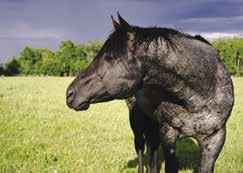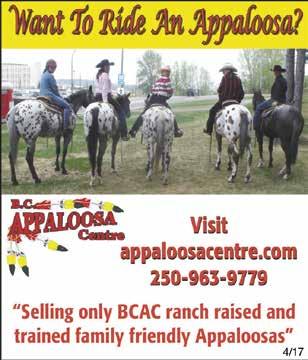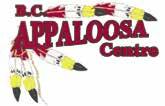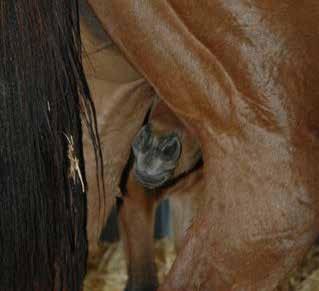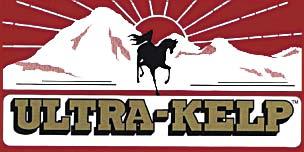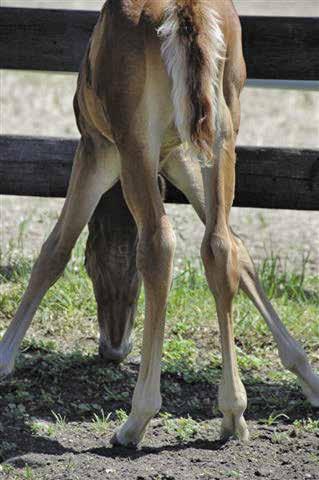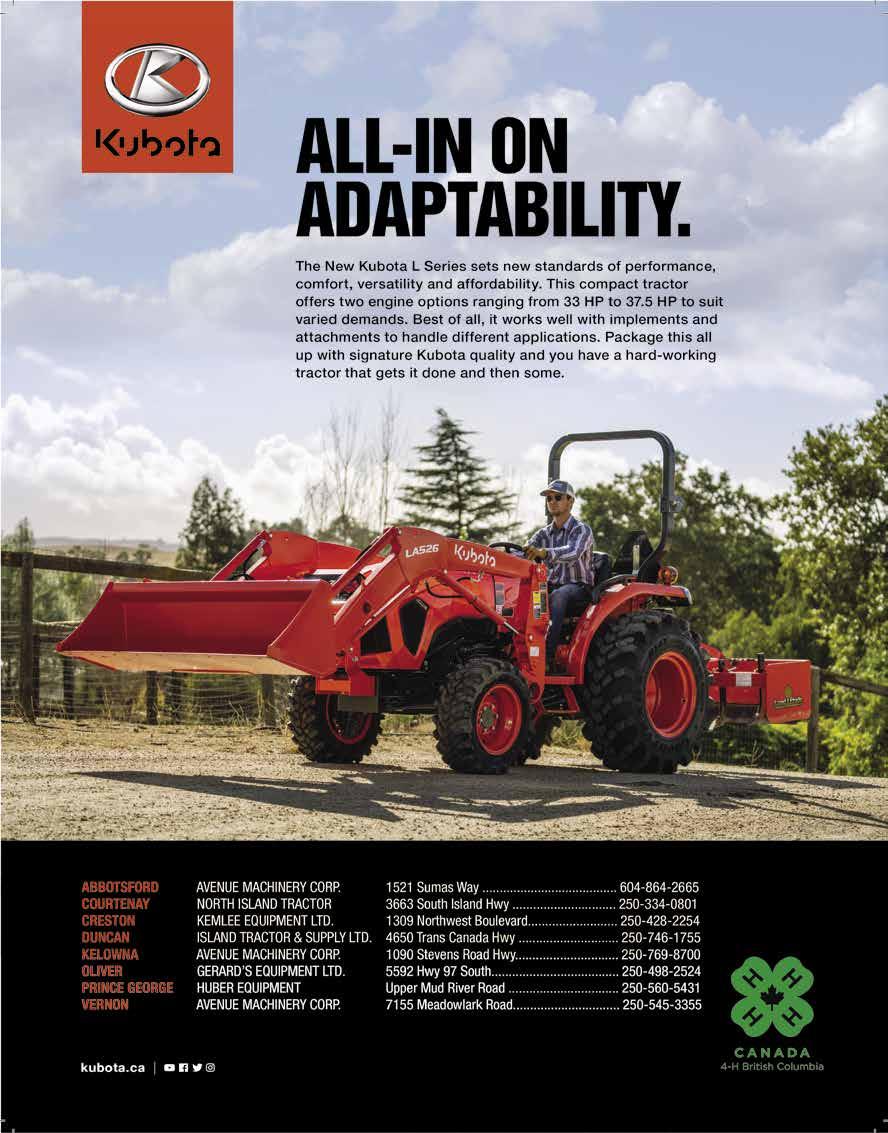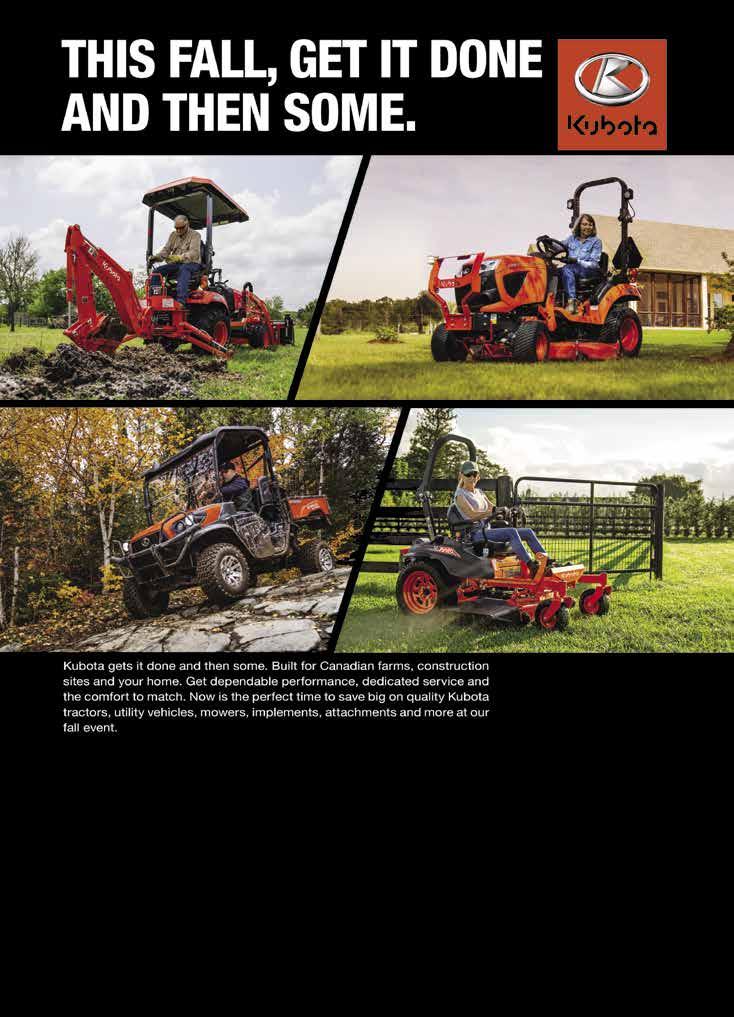








all started 22 years ago
a
announcement at

for Saddle Up magazine coming
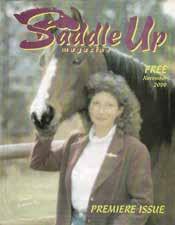
And the first issue was out, November 2000. It
‘community’
and it still is! We thank our
– with much
We have one more month (November) for our Fall Photo Contest for stables & equestrian centres to (possibly) win a 6-pack of the Rake & Shake Stable Fork – see page 6 for details.
What a gorgeous Fall we are having, and the weather couldn’t be better! Highs of 18 to 22C for October! Nice! Love the colours out there.


Wish someone would bring on a horse-related trade show in October… we are missing that. Not much else to do but wait for the snow to arrive I guess. Or head south for the winter… you lucky people!!
Some exciting stories and successful events in this issue… read on! And enjoy.
(On a sidenote, the November 18 Horsey Ladies Okanagan annual fundraising banquet is in person this year and tickets sold out online in 2 days. We have a waiting list for cancellations. See the group’s Facebook page.)


Elisha Bradburn, Elisa Marocchi,
Pilatzke, Sara
Shandro
Iread,with interest, the letter to the editor in the August 2022 issue of the Saddle Up magazine regarding “a new registration rule applied to APHA foals.” I do not know the person who wrote you this letter but I do have some comments.
1) Yes, the cost of registering foals of any breed continues to rise.
2) Parent verification using DNA analysis is a valuable way of identifying animals and is certainly less costly and much less fuss than blood typing.
3) In Canada, by law, the seller of a registered animal is
responsible, at their own expense, to transfer the registration certificate into the buyer's name in a timely manner. This has been the law for nearly 40 (forty) years! Many buyers do not know this but people who raise animals to sell certainly should be informed by now.
4) The price of a horse can reflect the expenses that the seller expects to encounter.
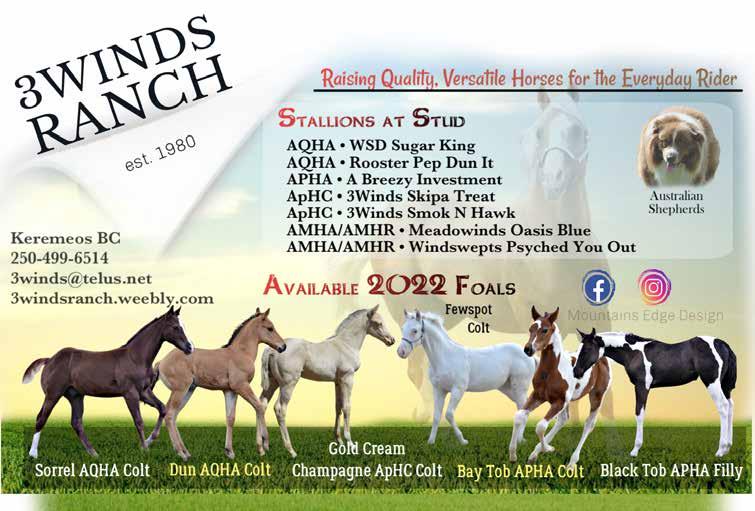
- Sincerely, Brenda Baker, Millarville AB


On
Our
The Finn
Don’t
The
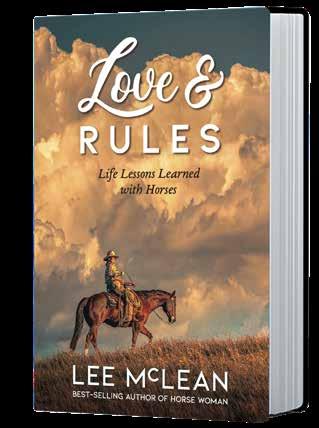 By Lee McLean
By Lee McLean
From Canada's beloved horsewoman comes a new collection of essays that covers the spectrum of love, fear, winning, loss, ageing, growth, illness and recovery — all through the medium of horsemanship.
A stroke survivor, horse trainer, and best-selling author, Lee McLean has over 40,000 followers on Facebook, a national magazine column, and she appears at events from small-town horse shows to sidesaddle racing at the Calgary Stampede.
The 'Love & Rules' Deluxe Edition features antique-finish paper and luxurious French flaps. Pour a cup of tea or a glass of wine — it's sure to make a decadent reading experience! But hurry, when the special editions are gone, they're gone for good.
We know you'll love this much-anticipated follow-up to Lee's multiple best-selling first novel, Horse Woman.
224 pages, Deluxe Edition
15.24 x 1.32 x 22.86 cm
eBook 978-1-989915-09-7 (coming 2023) $25.95
Publisher redbarnbooks.ca
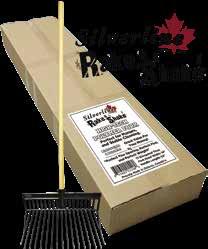

 Submitted by hcbc.ca
Submitted by hcbc.ca
Agricultural producers in the Lower Mainland and Kootenays will have access to mobile livestock emergency response trailers through a pilot project funded by the governments of Canada and British Columbia.

"Canadian producers have always shown great dedication to protecting the welfare of their animals," said Marie-Claude Bibeau, federal Minister of Agriculture and Agri-Food. "The new mobile livestock emergency response trailers will equip producers in BC with the necessary tools to help ensure the continued care and safety of their animals in emergency situations."
The Canadian Agricultural Partnership is providing as much as $67,600 to support the pilot project in BC. The trailers will be stationed in the Fraser Valley and East Kootenays, and will be available to support livestock producers during emergencies by providing specialized equipment to capture and contain animals and move them out of dangerous situations.
"BC agricultural producers continue to demonstrate their resilience and strength during extreme weather events and emergencies," said Lana Popham, BC Minister of Agriculture and Food. "These new mobile livestock emergency response trailers will have the supplies producers need during critical times to ensure they have access to the necessary tools and equipment to take care of their animals and keep them safe."
Each trailer will be equipped with livestock rescue supplies, such as horse and cow halters, sorting and corral panels, and tools. They will also carry supplies for producers, such as a first aid kit, safety/protective clothing, and a fire extinguisher. The trailers' mobile capabilities will allow the units to be deployed to other regions during emergencies.

The pilot is being led by the Emergency Livestock Response Committee that was formed in 2018. The committee aims to build upon the success of the pilot with additional trailers deployed throughout the province.
"The concept of having livestock emergency response trailers in BC was first introduced by RCMP livestock co-ordinator Cpl. Cory Lepine after attending a large animal rescue clinic in Alberta, so a committee consisting of interested industry group representatives was immediately formed," said Bob Miller, chair, Emergency Livestock Response Committee. "The steering committee extends their appreciation and gratitude to the governments of Canada and BC for the financial support and hope to see more trailers deployed in the not-too-distant future."
The Canadian Agricultural Partnership is a five-year, $3-billion commitment by Canada's federal, provincial and territorial governments that supports Canada's agrifood and agriproducts sectors. This includes a $2-billion commitment that is cost-shared 60% federally and 40% provincially and territorially for programs that are designed and delivered by provinces and territories.

Horse Council BC has put a great deal of effort into ensuring that Equestrian is held in as many communities as possible. Equestrian is though quite separate in many ways due to the need to accommodate our equine partners.

Although the Games were largely funded by the Government of BC which did include Covid recovery funding, together with major sponsors, our PSO Horse Council of BC funded a great deal of the Equestrian needs.

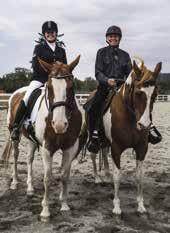
Our team of excellent Equestrian Chairs were: Dressage and Western Dressage: Claire Vessey Arena Driving: Tina Knott
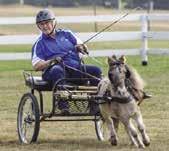
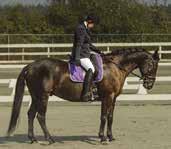
Working Equitation: Stella French

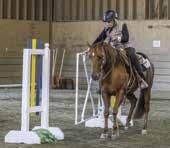

Working Hunter: Megan Soellner
Also keeping us on track for all Games Rules and Registrations: Zone 1 Representative: Carol Ann Rolls, along with all other Zone Reps within BC
When we started planning for the Games, Covid restrictions were in effect which were quite limiting for everyone, meaning that registrations were initially lower than expected. Once the restrictions were lifted and registrations were extended for an additional 2 weeks to July 15th, the numbers increased greatly. At the other end though, it meant we all had to work very hard to make the deadlines, but make them we did, and are so thrilled that the whole equestrian event was such a positive experience for the participants and volunteers.
The show office, as expected, was really busy for check-in and accreditation on the first day, ending with a really good Welcome BBQ hosted by Wits End Catering and sponsored by our local clubs, Lower Island Equestrian Club; Victoria Saanich Cadora; Vancouver Island Chapter of the BC Carriage Driving Society; Vancouver Island Working Equitation; an anonymous donor, and Horse Council of BC.
We’d anticipated about 50-60 and ended with an astounding 101 in attendance! Those attending included Sandy Underwood, HCBC Competition Manager and Craig Cherritt, HCBC Executive Director. As the 55+ Games are held to support ‘sport for life,’ a toast was made to our late Majesty the Queen, Elizabeth II as the ‘lifelong equestrian’ we all aspire to be.
As to the Games themselves, Wednesday being the first day of competition brought Dressage and Driving, then Working Equitation added on the second day continuing on in to the third day with Working Hunter extending into the last and fourth morning.
Once the competition started, we could feel the camaraderie building amongst the participants as they mingled together, all so supportive with each other and a large percentage participating in more than one discipline. The biggest crossover seemed to be between Dressage/Western Dressage and Working Equitation.
The 55+ Games are an almost completely volunteer run event usually held annually in a different city within BC. The choice of sports held is generally geared to those that the local community can support.Sheila, Cara, Claire
The Medal ceremonies were held once each discipline finished their own competitions meaning that presentations made were on Thursday/ Friday/Saturday. These were well orchestrated with music, flags and a small podium all ceremoniously managed by Marilyn McCrimmon and husband Rob. The final ceremony which was for Working Hunter, was made extra special with the surprise appearance of Pedro Cebulka, ringmaster supreme at many international events, wearing his striking, signature top hat and leading the winners in a lively trot to the music. For the very last presentation, the CEO of the 55+ Games Michael O’Connor arrived and he too, trotted along with the medal winners!
Now the final report has been done and all budget requests submitted, we are very relieved that the Equestrian part of the 55+ Games was successful due mainly to all our wonderful volunteers, that they ran on time, that we had no accidents or injuries and sometime very
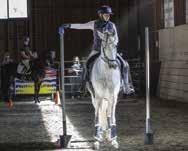


soon we will reminisce about this unique experience and say to each other - ‘thanks for having my back every step of the way!’
Sheila Skene for both of us…….
Sheila Skene & Claire Vessey, Equestrian Sport Co-Chairs, Greater Victoria 55+ BC Games 2022

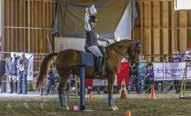

Horse Council BC would like to extend our utmost thanks and gratitude to all of the volunteers and participants of this year’s 55+ Games Equestrian competition. Like the saying goes, “it takes a village” and the village of Vancouver Island Equestrians were the reason the 2022 55+ Games Equestrian competition was a very successful and enjoyable event.
Now onto Abbotsford 2023!

In 2021, Rene Capps of Reno, Nevada, received a thermal imaging camera as a Christmas gift. The camera was purchased to help her diagnose any inflammation or hot spots, in an effort to prevent injuries in her horses. (She barrel races on the Women’s Professional Rodeo Association circuit and has some very high-calibre barrel horses.) To practice with the camera, Rene took some before and after photos of her horse Roman eating his feed.
“Roman is an 18.3 HH, 2,500 lb. Percheron,” explains Rene. “He lives outside and has a covered shelter. He has the winter coat of a wooly mammoth and is clearly in no danger of starvation. But I always wondered if he gets cold. I have bought him blankets in the past, but they didn’t fit him very well and he destroyed them, so that was the end of that.”

Obviously, keeping our horses warm, well-fed, and healthy is a top priority in Canadian winters, so we did some research into how best to ‘feed the furnace’ that fuels our horses.
“In my opinion, horses that are exposed to winter weather need shelter from wind and rain so they can conserve their body heat,” stated Everett Dixon M.Sc., a Mill Nutritionist with Top Shelf Feeds Inc. in Duncan BC. “They also need to increase their energy intake during cold weather by eating more grain or hay. Easy keepers should have access to coarse hay, as the digestion of fibre in the gut produces heat.”
Before Roman was fed his morning rations. You can see along his back, in the area more bluish than red, that he is not as warm as the rest of his body.
It was about -10°C (-18°F) when Rene snapped the two thermal imaging photos published here.
Providing extra feed is especially important when some of your horses’ other thermoregulatory mechanisms have not yet adjusted to sudden changing weather conditions such as a rapid drop of temperature. This extra demand for feed is called climatic energy demand. In the cold winter, the energy demand of the horse increases to counteract the heat loss to the surroundings and they increase heat production through continuously consuming and digesting long fiber.
Photo by Rene Capps.“It was interesting to see that when Roman started eating, he generated a ton of body heat and it did warm him up,” recalls Rene. But what REALLY surprised her is that her Facebook post showing the two photographs garnered 8.8K likes, 25 comments, and 8.7K shares. So, this was obviously something of interest to all horse owners.
“I had no idea that my social media post would generate so much interest,” reported Rene. “I’m so happy that it helped educate people and advocate for horses. This wasn’t a post ‘for or against’ blanketing horses, it was just me, being curious, and wanting to share my findings with my followers.”
“Horses need extra forage when the temperatures drop and grazing on pasture as their sole source of nutrition is not sufficient,” adds Dixon. “Winter pastures lack adequate vitamins, minerals and, in some cases, energy. A horse that needs to clear snow to find grass to eat is burning up calories that could be used to keep warm.”
Hay contains much less moisture than grass, so provide an unlimited source of clean, warm water to encourage additional water intake. If you notice your horses’ water consumption is down and/or their manure is dry and hard, take steps to increase water intake or your horse could develop ‘winter colic’ due to impaction of dry feedstuff in their digestive tract. Options to increase moisture include providing warm water, wet hay cubes, steamed hay, or soaked beet pulp. Clean your water buckets regularly. Try using a minty (alcohol-free) mouthwash to rinse them. And consider adding a little apple cider vinegar, molasses, caffeine-free soda, or an equine-friendly commercial water additive to the water. A salt
The darker red along the back indicates that Roman is completely warm everywhere, about 20 minutes after he had started eating. Photo by Rene Capps.
block should also always be available.
For a clipped and blanketed horse, or one with a summer coat, increase feed when the temperature starts to dip below 5°C. For a horse with a thick winter coat, feed more once the temperature is -8°C, or colder. An easy guideline to follow is that a sedentary mature horse will need two percent more high-quality forage for every degree the
temperature falls below the lower critical temperature. Smaller horses, ponies and older equines are less tolerant of cold temperatures and may need even more feed. Free access to a roughage of a suitable nutritive value for horses in a group provides them the opportunity to freely adjust feed intake. Horses that become too fat with free access could still get some straw or branches to chew on, since the act of digestion itself produces heat.
Those new to horses (or folks unfamiliar with keeping ‘outside’ horses) are often concerned when they see snow on their horses' backs. Does this mean they are cold? On the contrary, snow or frost accumulated on their backs shows that their hair is thick enough and trapping heat inside their bodies. It’s the same idea as a well- insulated roof on a home. Natural oil tends to let rain and snow slide off, keeping moisture from penetrating deep into the coat. If you see snow building up on your horse's back, it's proof that his body heat is not escaping through the hair to melt the snow. That said, if you live in a rainy and wet climate, like the lower mainland or Vancouver Island, blanketing may be necessary to keep the horse dry. A soaking wet horse will be a cold horse.
As with all horse husbandry advice, it’s always best to discuss your feeding concerns with your veterinarian and/or a qualified professional at your local feed store as overfeeding can result in a myriad of health problems and can also be a waste of expensive hay!

Reference source: Caring for the horse in a cold climate—Reviewing principles for thermoregulation and horse preferences by Cecilie M. Mejdella, Knut Egil Bøeb, Grete H.M. Jørgensenc. Published 2020.


 By Lindsay Ward, CTHS Alberta Division, cthsalta.com
By Lindsay Ward, CTHS Alberta Division, cthsalta.com
Revenue from the 2022 sale increased to $443,600 this year and the average price rose to $11,090. This increase established a positive move from sales of $405,600 last year for 37 yearlings and an average figure of $10,962.
The two $35,000 high selling yearlings were a Cape Canaveral colt consigned by Starline Thoroughbreds and a Birdstone filly consigned by Moonshine Meadow Ranch.
The colt is out of the Kafwain mare, Lil Missknowitall, who has produced 3 winners to date including the Alberta Champion Two and Three Year Old filly, Pearl of Knowledge ($207,825) and CTHS Alberta Sales Stakes winner Common Knowledge ($102,892). This yearling was purchased by Karlene Kingston as Agent.
The dam of the high selling Birdstone filly is the proven race mare, Silkworm, winner of the black type Freedom of the City Stakes. Silkworm has produced 2 foals to race, both winners, including Victory Built ($207,016). Birdstone is a classic winner of $1.58 Million and has sired 351 winners with over $31 Million in earnings including champions Summer Bird ($2.32 Million) and Mine That Bird ($2.28 Million).

Dermot’s Dilemma entered the ring as Hip 57 and marked the final yearling for the leading Alberta sire, Cape Canaveral. The Mr. Prospector son was the foundation sire at Highfield Stock Farm for fourteen years and a leading sire in Canada with progeny earnings of over $17.8 Million. Cape Canaveral recently passed away after being pensioned last fall.
Starline Thoroughbreds was the leading consignor both by average and gross sales with three yearlings consigned for total sales of $96,000 and an average of $32,000. This consignment included the high seller in addition to two other Cape Canaveral yearlings out of the Latent Heat mare, Whinny Magoogin and the Tribal Rule mare, Rubyintheruff.
The leading purchaser by gross sales were Carole & Jim Barker and Red Ron Farms who purchased two yearlings consigned by Stone Ranches and Boe & Janet Stone for a total of $54,000. Their new acquisitions included a gelding by Ransom the Moon out of Carolina Station and a Gormley filly out of Ron Rhonda.
Seven horses were purchased through online bidding this year, the most in the three years this option has been offered. CTHS Alberta Sale was able to provide real time viewing and online bidding through a partnership with Direct Livestock Marketing Services (DLMS). Our appreciation and thanks goes to Highfield Investment Group Inc. and Century Mile Racetrack and Casino who made this service possible.
Thank you to all the consignors, purchasers and viewers for their support of the 2022 CTHS Alberta sale and the Alberta Thoroughbred industry.

A yearling colt and filly duo set the high seller mark at $35,000 during the 2022 CTHS Alberta Thoroughbred Sale held on September 16th at Westerner Park in Red Deer, Alberta. A total of 40 yearlings sold resulting in overall positive increases in gross sales and average at the completion of the sale.
A 2021 study conducted by the Alberta Equestrian Federation (AEF) found the diverse mix of equine ownership and activities in our province had a significant financial impact on Alberta’s economy. In terms of gross domestic product, Alberta’s equine community contributed nearly $1.4 billion.

Albertans are passionate about their horses, donkeys and mules. These equines are an integral and valued part of our province’s culture and history, which has been carried forward from the past to the present.
These past few years have been challenging for all Albertans, let alone horse owners, as we have dealt with the hardships of wildfires, floods, and an ever-changing pandemic. The one constant that has remained unchanged, however, is the commitment to our equines. The Alberta Equestrian Federation (AEF) has sought for many years to better understand the Albertan equine community and its contribution to the province.
In 2021 AEF hired an independent contractor, Serecon Inc., to conduct a study to determine the current status of Alberta’s equine community and estimate the economic benefits that it contributes to the provincial economy. The study was designed to capture the impact of all businesses and services in Alberta that connect, directly and indirectly, to the equine community and its related industry.
The diverse nature of the equine sector makes it challenging to capture data. Despite the complications, the AEF believes that understanding the economic footprint of this sector will assist all interested groups in making important decisions that will contribute to a thriving, growing equine community in Alberta.
AEF worked with key stakeholders in the equine community, using their knowledge and experiences to design a comprehensive survey. AEF administered the survey through multiple social media groups and electronic distribution tools in the fall of 2021, with a total of 1,520 responses from a wide array of industry and community participants. Interviews were also conducted to validate and build our results.
Various data techniques and models were then used to capture and analyze data collected. Survey responses were systematically analyzed to ensure the complex nature of the industry was appropriately summarized.
• The diverse mix of equine activities makes a significant financial contribution to the province. Findings indicate the total economic impact of the equine community in terms of gross domestic product amounted to $1.356 billion in 2021.
• All expenditures related to the equine community totaled over $1.7 billion. These expenditures resulted in a contribution of $855 million in labour income.
• The equine community has a notable impact on employment in Alberta. Analysis reveals that over 20,300 full time equivalent (FTE) jobs are contributed after accounting for all equinerelated expenditures.

• Study results show Alberta’s total population of horses to be just over 142,000 horses, kept on over 25,000 properties. Roughly 50 per cent of horses are used for recreation (backyard ownership, trail riding, summer camps, etc.), 38 per cent for sport (western, jumping, dressage, vaulting, etc.), and six per cent for work (outfitting, ranch work, guiding, etc.).
• When it comes to overall expenditures (training, board, feed, health care, etc.) per horse surveyed, owners of horses used for sport pay nearly twice as much (at approximately $12,700 per year) as those used for recreation (approximately $7,500), and over three times those used for work (approximately $3,700).
This study shows the equine community’s significant impacts across the province, demonstrating the great importance of this diverse and wide-reaching sector. Findings will help determine the best way to enhance and grow the equine community. They will inform decisions in many areas including agriculture, sport, recreation, and government, and help identify future trends and drivers of change.
AEF is committed to sharing and using the study information to develop and enhance our programs and service offerings, attract new partnerships, strengthen existing partnerships, and supporting other groups in the equestrian community whenever possible.
For more information and to access the study, visit albertaequestrian.com
The first position of doubling on the ground in a rope halter - I am adding pressure and asking Hefner to think his way through the pressure of my rope and follow a feel.
The middle phase of doubling - Hefner understood to give to the pressure and turn towards the feel on the rope.
The final phase – I am pleased Hefner thinks his way through the pressure of the rope quickly and also returns to a calm state quickly.
By Elisha BradburnSounds kind of redundant, right? You would think if you were preparing for the worst, you might also expect the worst. With horses though, you want to do just the opposite. Prepare them for worst case scenario, but go into every situation with a hopeful expectation for the best possible outcome. Let me explain what this may look like in practical terms.
put some serious thought into preparation when my friend and mentor, Miles Kingdon, came out to my place to give me a hand starting my 3-year-old colt, Hefner. I am generally a pretty calm and quiet person, and like to keep things gentle and soft as much as possible. My colt has responded beautifully to this kind of approach. To give you some context, Hefner has been with us since he was a weanling, and the lady we bought him from is a fantastic horsewoman and rancher. Hefner came with minimal handling, growing up out in a big pasture with other mares and foals, but what handling he did have was good. He was a nice blank slate so to speak. Exactly what I was after to see what it would be like to have a fresh start, not an intervention on some gristly defensiveness and shut down behaviours built up by poor past experiences, or alternatively, just reaping the benefits of another horseman’s good work. This horse would be a reflection of me in many ways, since I was his primary source of interaction with humans.
To get back to the story, I thought I had some good stuff going on with Hefner. He was so at ease with my handling that he would take a nap while he stood to be groomed, yet would still go and stop at the slightest suggestion from my subtle body language when doing ground work. This was good, and Miles seemed pleased with the soft manner in which Hefner responded to requests.
What I wasn’t thinking on though, was how would I prepare this colt for the worst?
How solid was our foundation if it got shook?
How would I prepare him for when the environment went from serene to chaos, a dog jumps out, a snake rustles through the grass, a gun is shot, or heaven forbid… a plastic bag blows by!
This caused me to think maybe there are a few folks out there in the same boat as I was that day, unaware of the importance of setting our horses up for success when things get “real.” This caused me to want to share the possibly life saving importance of preparation that was impressed upon me that day, and the subsequent discoveries made.
Back to that day… I handed Miles my happy, calm little colt that lovely spring day and watched him take the soft, melodic, biomechanically correctly moving little guy to a wideeyed maniac in the blink of an eye. The mere act of Miles asking him on the ground to change
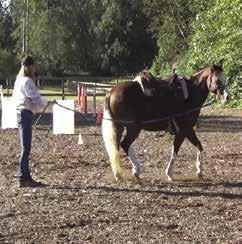
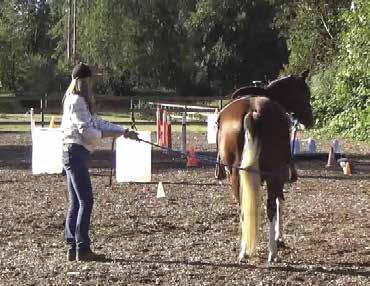

direction with some speed, and pick up a trot caught him completely off guard which caused him to unpack his suit case full of crazy. It was interesting, and mildly concerning, to see that simply picking up the pace, and level of ask on Hefner, was enough to make him come a bit unglued. Miles was neither rough, nor unfair, he was simply asking Hefner to change gears, to which he responded by getting pretty elevated and becoming rather dangerous if you were to be on his back. This was exactly Miles’ reason for upping the level of ask with a sense of urgency. He was setting up the perfect storm to see what would happen. Miles warned me that if I never increased the pressure, I would never be able to teach Hefner to think his way through pressure without becoming emotionally unstable. I know Miles was wanting me to see what was lying just beneath the surface of my seemingly calm colt. He was concerned if this preparation was not done now, in a controlled environment like we had that day, that it could take place at a rather inopportune time, out on a trail somewhere, with me on his back, and the results could be less than favourable. It was part of my education on preparing the horse for success.
A s I moved along with Hefner I kept this lesson close to my heart, and thought of how important it is to prepare our horses properly to think their way through pressure situations without having a dangerous melt down. I would much rather experience the most raw, wild behaviour my horses are capable of while at home, or while I am setting up something on purpose, than to experience it when I am trying to get a job done, or enjoy myself. So, what does this preparation look like for you? It will very much depend on where you and your horse are at as far as experience, whether you would endeavour to do this on your own, or with help from another knowledgeable horseperson. But simple things like in increasing your ask, adding some speed and quick changes, different scenery, obstacles, etc. all add pressure. The key is taking your horse to the point they are outside their comfort zone, but not “seeing red” so to speak. This means they get a little alarmed, but you set them up to think their way through to the solution. Working incrementally, and of course with feel and timing are the keys to doing this while still maintaining your horse’s trust in you.
An example of this setting the horse up to think its way through pressure is doubling them when you are acclimatizing a horse to a hackamore. I won’t get into the technical aspect of how to properly double a horse in a hackamore, but essentially, we want to see what the horse does when he hits the pressure of the hackamore with some sense of urgency. This will simulate if we were actually out and somebody’s horse spooked, or a rope got under his tail, or for a variety of other unforeseen reasons, he became alarmed, and this caused him to hit your pressure on the hackamore quickly and with some force. We
want him to still be able to think his way through that pressure, and not be so fearful and shocked in that kind of situation that his mind is lost to panic. We want him to be able to feel afraid and still think “if I just give to the pressure, seek the human’s guidance, everything will be ok.” If we never let our horses experience some level of fear and discomfort in a controlled environment, we set them, and ourselves up, for a potentially disastrous situation when things unexpectantly get a bit western when we are out and about.
Pat Parelli has this amazing little diddy that goes something like this “Prior and Proper Preparation Prevents P-Poor Performance…” - Parelli Natural Horsemanship, and so I leave you with that, as a way to remember the importance of preparation. This preparation should be foundational in what we venture to impart to our horses, to better them for their own well being, as well as ours, and any person handling them after us.
Until next month friends, wishing you happy and safe times with your horses, and remember – Prepare for the worst, but expect the best.

Elisha Bradburn and her husband, Clay, own Faithful Farm, an equestrian center in the Fraser Valley. Elisha’s passion with horses lies in psychology based horsemanship, with a strong consideration for the horse’s point of view. Elisha is available for clinics, expos, demonstrations and speaking engagements and can be followed on her Legacy Horsemanship pages on Facebook and Instagram or e-mailed at legacyhorsemanship@shaw.ca.

(See her listing in our Business Services section under TRAINERS)

Whether you consider cones courses to be the best part of a CDE, or your worst nightmare, completing them problemfree can be a challenge. Having judged a number of cones competitions over the years, I’ve seen people make mistakes that cost them unnecessary penalties or even resulted in elimination. In this first of two articles on driving cones courses, I’ll give you a few hints on walking the course and what to do before you actually cross the start line to begin your round.
Let’s start with some thoughts on walking the course at an event. Give yourself enough time to walk the entire course as many times as you need to, until you have it committed to memory, but check with the technical delegate beforehand to ensure the course has been opened for walking (at more formal events, the course may be open only for a short while just before the start of the cones competition). I like to walk the course the first time just to get an idea of the layout, then I walk it repeatedly until I have it memorized and have worked out things like alternate route choices and tricky angles.
Drivers with mobility issues are permitted to drive through the entire course in a golf cart or similar vehicle, however you are allowed to do so only at a walking pace.
While you walk, stick to the exact line you’ll be driving - don’t cut any corners or take shortcuts from one set of cones to the next. This will help you set your turnout up correctly when you are actually on course. If you are double checking your line to a set of cones, go back to the previous set and walk from there. That way, you’ll be sure to get the correct angle of approach.
Some courses include “optional routes.” In these situations, the course designer is offering you two options for a given set of cones. For
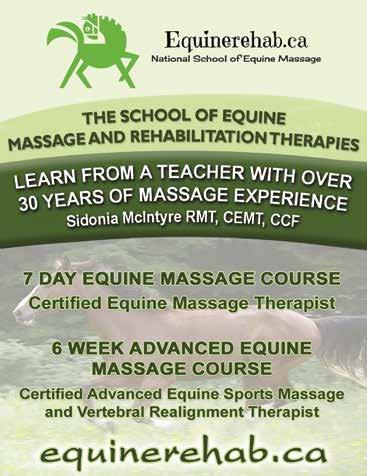

One of my all-time favourite driving students took great pride in telling people that he had managed to eliminate himself from the cones phase of many combined driving events by way of a different rule infraction each time! While he certainly completed many courses successfully, his comment reflects the fact that the rules and procedures for driving cones competitions can be tricky.
example, you may see two pairs of cones on course, both marked with red and white “5”s. Typically one set will be on a longer but more easily driven path, while the other option will be shorter but with a more difficult or problematic approach. The course length will be measured using the longer option, however if the course is difficult in other areas, you may need to make up time and thus might consider using the shorter, tighter option.
While it may seem like a great time to socialize and catch up with fellow drivers, you should do your best to concentrate on the course as you walk it. Pay attention to both the order of the cones and the direction you need to drive through them; don’t just follow someone through the routes as they walk in front of you. I’ve seen competitors following another person backwards through a set of cones as they walk so don’t assume the other person is walking the course correctly! And please leave your canine friends at your trailer while you’re out there.
When planning your route, be sure to include the path you will take from the ingate to the judge’s stand, where you will halt and salute prior to starting the course. You will also want to decide where you will drive after the judge has given you the signal to start the course. You have up to 45 seconds to cross the start line after the start signal, so plan on making good use of at least some of that time. Some courses include decorations or elements your horse might find distracting, so if you have the option of trotting by them before starting the course, do so. I generally plan to stop reasonably close to the judge (so they can see that I’m there, ready to deliver the salute), and pointed in a direction that will allow me to settle my horse into a forward, rhythmic trot well before crossing the start line, after the signal has been given.

The procedure for starting the cones course seems to cause confusion for many inexperienced competitors and to compound this




confusion, the process for entering the cones area and preparing to commence your round sometimes varies from event to event.
Your gate person/whipper-in will let you know what you need to do but if you are confused, ask for clarification. Typically, you’ll wait until the previous competitor has completed their round, then you’ll enter the competition area and approach the judge. Some events wait until the cones setters have moved off the course before allowing you to enter the area, while others, especially at a busy event when they are trying to be efficient, will ask you to enter while the cones setters are still working. Once you are allowed into the course, proceed promptly and directly to the place you’ve planned on stopping at in front the judge, offer them a salute, then listen for the start signal.
You’ve heard that signal and are heading for the start line! The next issue’s article will explain some of the more confusing rules governing cones competitions and how to deal with them when you’re on course.
Elisa Marocchi is an Equestrian Canada licensed driving coach and a member of the EC Driving Committee. She owns and operates Wildwood Farm, a full service driving facility near 100 Mile House BC. An active driving coach since 2000, Elisa offers clinics and lessons in a safe, supportive and fun manner both on and off the farm. As a combined driving competitor, Elisa has successfully competed throughout North America with both her own homebred horses and those of clients.
(See her listing in our Business Services section under TRAINERS)
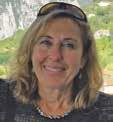













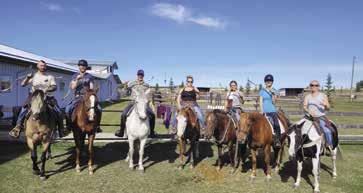
 By Robyn Skelly
By Robyn Skelly
Speaking from experience, I have always found it incredibly difficult to get started in new equine groups. This community can be tightknit and cliquey, and these feelings tend to surface more for me when meeting new equestrians. This nervousness may be the reason you haven’t taken up opportunities to join some other social situations as well, like drinks with colleagues after work or a new school activity. If this is resonating with you at all, do not worry… you are not alone.
O f course, joining a new group is going to bring up some negative thoughts, but learning how to conquer these feelings will help make these circumstances less intimidating. Truthfully, all of our hesitancy towards meeting new people stems from the mental barriers we have imposed upon ourselves, or the fictional conversations or scenarios we conjure up in our minds that we frankly do not know will happen. It is natural to have these notions and it can seem daunting to look past them, so I have included some tips and tools to get past those nagging emotions.
At a July "Intro" clinic in Kelowna, the property owner's kids all but demanded that we teach them during the lunch break. Here they are on our quad trailer with saddles we use as a training aid to get people used to shooting from the saddle.

in with achievable goals like ‘I would like to learn 5 new people’s names and stay in a positive mindset. Secondly, accept the fact that you must leave your comfort zone to learn something new and exciting. Joining a new group is both intimidating and rewarding in equal measure, but we all know from past experiences that the dread doesn’t last; it’s the connections and memories that do.
This is just a roundabout way of saying that you simply have to commit and jump in headfirst! Ask lots of questions, stay involved and active during the group's session, ask for other people’s names and introduce yourself lots. Easier said than done (I know), but if you start to take real steps towards conquering your fears it becomes easier the next time. Gaining confidence in new situations and new social groups only becomes painless with repetition, so get yourself out there, sign up for the next clinic you’ve been wanting to go to, join a new club at school. And (obviously), sign up for a lesson or clinic with Okanagan Khanate Mounted Archery (OKMA)!
Start first of all by remembering that everyone in the group was ‘the new guy/gal’ at one point or another. Find comfort in the fact that these people know how you must feel and likely want you not to experience the awkwardness and tension they felt when they joined. Do not hold high expectations for your experience: stay realistic, go
Throughout the last year of helping run OKMA, I think my favourite part has to be the people we have met through our clinics, lessons, and social gatherings. We have such a wide range of members, and the intergenerational collegiality is a beautiful thing to witness and be a part of. It is hard to find true community in the equine world, with a wide range of people gathering to enjoy the same activity. Yet, at OKMA I believe we have established the environment for this kind of group to come together. We have active members in the 5–10-yearold range all the way up to retirees who come to enjoy horseback archery as their hobby.
So, the point is, if you have been at all hesitant to come join a lesson or practice or clinic, we encourage you to take the leap. We want to see you here and welcome people coming alone or with friends or family. Our vision for OKMA is to help connect like-minded people and for everyone to have the chance to create lasting friendships.
There is no pressure here to be somebody or to prove yourself; just show up, come ready to learn this thrilling sport and come make some new friends!

Joining a new club, sports team, or social group can be a stressful and anxiety-provoking activity for most if not all of us. The idea of meeting with a group of new people may have you asking questions such as ‘Will they like me?’ ‘Will I fit in with this group?’ and ‘Will I make a good impression?’Sunday practice/grading competition on the IHAA Tower 90, Raid 1-2-3, and Turkish Tabla courses in Olds, AB (Sept 25, 2022) with members of OKMA and Kaspian Mounted Archery.
We took lessons from Diane Sept at Westridge Farms owned by Helen and Ron Williamson. By the time 10 lessons were over, I purchased a little red gelding, 7L’s Proud Pal, from Donna Henry and boarded him at Westridge, Calgary, AB.
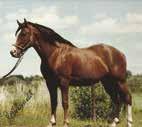

At Westridge, I became aware that a group of TWH owners were working on a big project - a Canadian Registry for Tennessee Walking Horses. I was impressed and intrigued by their vision and determination. The Registry was founded in 1982. As I met more of the people involved with Tennessee Walking Horses, my involvement with the registry grew.
Today it seems impossible that 40 years have passed since those riding lessons. It is hard to believe that in 2022, the Canadian Registry of the Tennessee Walking Horse (CRTWH) will be 40 years old. As we reach the 40th Anniversary of the CRTWH, I have been pondering what I personally can do to celebrate this important milestone. I have considered a variety of projects, but for one reason or another, nothing seemed to be worthy of the amazing vision and accomplishment of that small group of determined people.
A s I examined my 40 years, I kept coming back to “The Canadian” Futurity. I reread The Canadian Times of the TWH, a publication issued yearly during The Canadian Futurity. The 2003 issue included an article entitled ‘Uniquely Canadian’ with a pedigree that included a large number of horses that, while not necessarily all registered with CRTWH, resided in Canada and in some sense could be considered ‘citizens of Canada’. A pedigree with pictures was developed for this Uniquely Canadian Horse, Chapie’s Summer.
A recent CRTWH contest asked “How many CRTWH registered horses are on the registration papers of your horse?” Including the horse itself, there can potentially be 31 horses on a CRTWH certificate. To my astonishment, entries to the contest included 3 horses with 25 Canadian registration numbers and 2 horses with 21 Canadian registration numbers. I was amazed. Is it possible there was a horse or horses with even more than 25 Canadian registration numbers on their registration certificate?
I’d found my project! A fitting tribute to the CRTWH visionaries would be the following:
• To determine the horse or horses with the most Canadian numbers on the registration certificate.
• To develop a picture pedigree of that horse or horses. The ultimate result would be a visual of the pedigree of The Most Canadian Horse as of 2022.
• To compile a digital pictorial library of every CRTWH horse (alive or deceased), including its registered name and the number of CRTWH horses on its pedigree.
A s with most projects, I cannot do this alone – I need the assistance of past and present owners of CRTWH registered horses. I invite you to submit a picture and registered name of your CRTWH horse, including the number of Canadian registration numbers on the registration papers. Don’t forget to add the horse itself in the picture to the total CRTWH numbers on the registration papers.
Send pictures of present or past CRTWH registered horses to Dianne Little at ddlittle@telus.net or call 403-874-1023.
If you know of a suitable candidate for the Most Canadian Horse (determined by the total numbers on its Registration Papers), please contact Dianne Little at ddlittle@telus.net.
Waltztime’s Classy Socks, first one registered under the auspices of the Canadian registry, is the colt in the photo with his dam, Chapman’s Waltztime #91. Sire was Prairie Breeze #93, both registered in the Canadian Livestock Records General Stud and Herdbook.
Chapie’s Summer, The ‘Uniquely Canadian’ TWH, born in 1997, [CAN]#1988. There are 19 Canadian registered horses in her pedigree.

One of my dreams was to own a horse.
In 1981 my long-time friend Sue and her husband Jim purchased a Tennessee Walking Horse. When Sue asked if I would like to take lessons with her, I did not hesitate! That was the beginning of my journey with horses, in particular the Tennessee Walking Horse.Prairie Breeze 93
It was under near perfect weather conditions that the 2022 BC Ag Expo was held September 23-26 at the North Thompson Fall Fair Grounds in Barriere BC with 261 4-H and Open contributors attending.
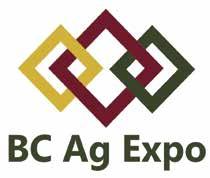
The Horse division was a busy place with 22 4-H members and 2 Open Youth Little League members competing over the weekend in the show.

Friday the judges were Ally Crawford of Barriere and MacKenna Fink of Kamloops, both of whom are 4-H Alumni, having been long time members of the Double L 4-H club. They got straight to work judging showmanship, horse equitation and 4-H judging classes. The day wrapped up with Chloe Smith of Yellowhead 4-H taking home the WB Mobile trophy for Overall Horse Showman and prizes sponsored by Kamloops Large Animal Vet Clinic. Emma Muddiman of Shuswap 4-H excelled at the Horse Judging classes coming out with the 2022 Overall Horse Judging award.
Saturday and Sunday saw Jan Brant take over as the official judge. Saturday highlights were the awarding of the Overall Western Hi Point sponsored by Prairie Coast Equipment to Alexis Nelson of Yellowhead 4-H Club and the English Hi Point, sponsored by The Dawson Group, went to Katie Biagioni of the Rodeo Rednecks 4-H Club.
The weekend rounded out with Horse Show & Fit, some fun games and the Trail & Handy Horse classes. Jayli Mayer of Four Corners 4-H took home the Overall Trail award.




425 people sat down to a fabulous roast beef dinner provided by Salt Lick BBQ Sunday night for the awards banquet, which saw Jayli Mayer of Four Corners 4-H receiving the 4-H Super Horse Award and Torri Harkies winning the Little League Super Horse. After a night of dancing to the DJ music of Insanity Sound, it was time to say goodbye to all the friends made at the fair and head home to eagerly await the 2023 BC Ag Expo.
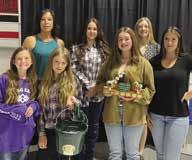
The Ranch Horse Revolution Club (RHRC) was officially established in the summer of 2022 and sought to tap into and promote the growing demand for the ranch horse discipline within BC. It all became a reality when all the stars aligned, and we officially had a date for our very first show, which was only 6 weeks away at the time!
Once we got the word out about the show, we were absolutely astounded by the amount of support from the horse community and all the sponsors! There was clearly a demand for a show dedicated to the ranch horse discipline, and we worked day and night to make it happen.
On September 17th, the RHRC successfully held their first open all-breed ranch horse show in Armstrong BC, with Jodie Moore as the judge.
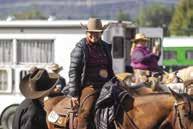

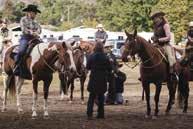

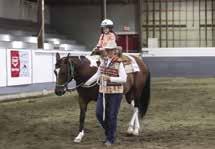

The exhibitor numbers far exceeded our expectations, with 37 horses and 185 entries for the day (WOW!). This success was due to the amazing sponsors, volunteers, and directors that have driven our club and the resulting show. It fills us with pride to have experienced such a fun, friendly and supportive atmosphere. Our goal was to welcome every breed of horse and every level of rider while maintaining the heritage of the working ranch horse.
We had seasoned exhibitors, some with showing experience from 10 years ago, and some who were attending their very first show! We also had exhibitors from as far away as Calgary, Lone Butte, Grand Forks, Spences Bridge, Chilliwack, and many from the local area as well.
The RHRC has two shows tentatively booked for June 24th25th and September 16th-17th 2023. We are also planning some educational clinics in between! Please stop by our Facebook page, “Ranch Horse Revolution Club,” as we post the latest updates.

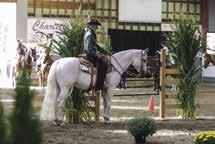
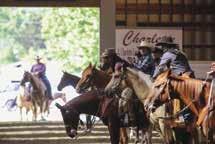
Thank you immensely to everyone who lent a hand (or pitchfork!) to making this event the smashing success we had envisioned!
A
We
Green Horse/Rider
Highpoint:
Green Horse/Rider
Mandy
Wild Mane Photos.
Youth
Senior
Green Horse/Rider
Highpoint:
Sportsmanship:


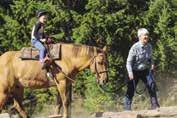
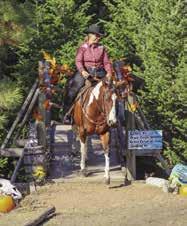
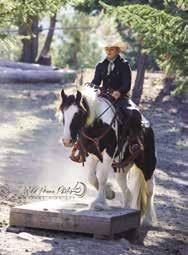

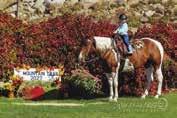
On a sunny and warm October 1st, 2022 Canoa Farms had their first stand-alone Mountain Trail show. Only 3 weeks earlier the BC Mountain Trail Association cancelled our show off their circuit. First thought was to cancel the show all together - but messages from supporters encouraged that “The Show Must Go On.”
We changed it to a one day show and the entries started coming in. We had 46 horses and spectators from the Cariboo, Okanagan, Interior, Germany, Switzerland and Lower Mainland. Most classes had over 30 entries and the amazing judges… Mary-Lou Barker from Oliver BC and Susan Mathews from Lone Butte BC… went into overtime to get all classes done by the end of the day.
We had Green and Novice Divisions, plus 2 specialty classesLead-Line for our future champions where everyone was a winner, and the Gamblers Choice to spice things up a bit! Elana Wharry gambled 20 points and roped the cow dummy for a lovely custom created casserole sponsored by Spotted Horse Studio who sponsored all the classes with pottery trophies.
So much positive feedback has us excited for next year’s Trophy Buckle 3-day show July 21-23, 2023.
1-Lisa Babij
2-Laura Bartsch
3-Isabelle Gorman
1-Sierra Blackmore and Maggie (Pinantan)
2-Diane Kempton and Brio (Maple Ridge)
1-Maizie Gorman
Gorman
Freeman
1-Elana Wharry
(Langley)
2-Cayleigh Wharry and TomBill (Langley)
3-Simonne Rempel and Nisa (Merritt)
in Hand - 6 entries
3-Kristen Mozel and NF Aslans
(Lone Butte)
Green
1-Cayleigh Wharry and TomBill (Langley)
2-Isabelle Gorman and Roxy (Summerland)
3-Katie Wakefield and Hayes (100 Mile House)
1-Isabelle Gorman and Roxy (Summerland)
2-Maizie Gorman
Sunday
1-Marjorie MacKay and Kessler (Langley)
2-Elana Wharry and Ally (Langley)
3-Simonne Rempel and Nisa (Merritt)
Novice Rider - 9 entries
1-Marisa Hofslette and Heza Dust Storm (Entlebum Switzerland)
2-Simonne Rempel and Nisa (Merritt)
3-Elana Wharry and Ally (Langley)
Novice Horse - 8 horses
1-Kristen Mozel
2-Margo Murray
3-Katie Wakefield
Aslans
(Lone Butte)
(Kamloops)
Hayes
1-Isabelle Gorman and Roxy (Summerland)
2-Elana Wharry and Ally (Langley)
3-Simonne Rempel and Nisa (Merritt)

Heaves is known as a disease that can leave a horse struggling to breathe, ending athletic careers and even rendering a pleasure horse unsuitable for riding. Commonly known today as equine asthma, it’s an irreversible disease brought on by repeated exposure to dust and moulds. Ontario Veterinary College researcher, Doctor Bienzle has a long history of primary and collaborative work studying asthma in horses. Her most recent contributions include working with a group of researchers in Slovenia, investigating stem cells as a potential treatment option.
Bienzle explains the usual causes of heaves are long term exposure to dusty or mouldy hay, bedding, dusty environments and sometimes even grass in hot humid climates that provide the right conditions for mould to thrive. “Horses get sensitized to these components in the inhaled air and with time, they develop airway inflammation and that begins to manifest with occasional coughing or runny nose.”
With continued exposure to the same particulates, the condition worsens, and the coughing becomes more continuous. The nose may be running and then there is thickening of the bronchial wall in the lung. There is extra smooth muscle being laid down and it becomes hard for the horse to exhale against mucus and inflammatory cells in the lumen of the airway.
In the later stages of disease, horses can develop a ‘heaves line’ (hypertrophic abdominal muscles are recruited to assist with exhaling air). By the time equine asthma is diagnosed, it has usually been present for a few years, if not several. Treatment of the symptoms includes immunosuppression, but the disease cannot be reversed.
“ The vast majority of the horses are unable to perform as athletic horses or even as a companion horse with a little bit more strenuous riding,” says Bienzle. “It’s an incurable disease for the most purposes. It’s somewhat treatable, but not curable.”
Dr. Bienzle elaborates on the importance of good hay, clean air and other important stable management considerations in a video interview (see https://thehorseportal.ca/2022/09/stemcells) where she goes on to explain the exciting new research investigating stem cells as a potential future treatment option.
The potential to downregulate inflammation with a biologic therapy like stem cells versus traditional drugs, like corticosteroids is clearly attractive. For administration of treatment, Bienzle explains there are already well-developed methods for examining the lower airway using endoscopes. Administering stem cells using this targeted method may be an appealing option versus intravenously where it is uncertain where the treatment ends up.
When explaining the challenges and expertise required to produce stem cells, Bienzle says, “This is not for the casual investigator because it takes some experience to have the right culture conditions to make sure those cells are clean. They are not cultured for very long, and when the final preparation is administered to an animal, it must be free of cell culture components that could make inflammation worse.”
The preliminary, proof of concept work is quite exciting, with stem cell therapy outperforming traditional corticosteroids. Stem cells have no side effects per se, as many drugs do, which makes the study of biologic treatments very attractive.
This study, “Effect of intrabronchial administration of autologous adipose-derived mesenchymal stem cells on severe equine asthma,” published in Stem Cell Research and Therapy, was funded by the Slovenian Research Agency fund. The ground-breaking work is in its infancy with future studies planned which could one day help horses, and potentially humans suffering from asthma utilizing biologic therapy.
More tips on equine respiratory health available for download at Equine Guelph.ca.
Dr. Bienzle has recently been named to Canadian Academy of Health Sciences for outstanding contributions in the field of research.
Congratulations (so far) to: Lynda Norris, Spallumcheen BC
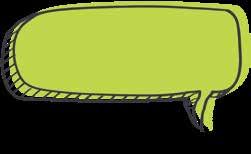
Jackie Grant, Courtenay BC
Marie Graham, Vernon BC
This was a tabletop Juke Box Record Library and music selector. A common piece of equipment found in restaurants in the 60s to 80s. People sitting in the booth could insert the coins to have their selected music played thru the restaurant for the patrons.

Congratulations also to: Yvonne Olson, Cumberland BC Ester Brittain, Penticton BC
Made of chrome plated steel. Item on left is 6” long and weighs 7oz. Items to the right are 5” long with a point and weighs 2oz.
Discuss this item with your friends and send your guess to usedandunique2018@gmail.com
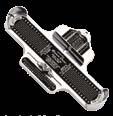
Do include your city and province please. Saddle Up will print names (and location) of those with the correct answer in a future issue.
If you or your company would like to sponsor this monthly brain teaser, do call 1-866-546-9922 or email nancyroman@ saddleup.ca for details.
Many people will be able to explain what the item is used for, BUT DO YOU KNOW THE NAME OF IT?
Equine Guelph, equineguelph.ca, thehorseportal.ca
Rescued in Face of Danger
What if your pet was injured and suffering but you weren’t able to help them? This was the case recently for the family of Jax, a boxer-cross whose leg was broken when he was struck by a vehicle.
Jax’sfamily was in the midst of a fire evacuation in their hometown of Lytton BC when the accident occurred and they weren’t able to get their beloved dog to a veterinary clinic. They reached out to Emergency Services in Cache Creek, who called the BC SPCA for help.
“One of our animal protection officers, Constable Kent Kokoska,
immediately drove out to meet the family and brought Jax back to Kamloops for veterinary treatment,” says Sarah Gerow of the BC SPCA in Kamloops. Jax was assessed by specialists and underwent surgery to repair his broken leg. He was then transferred to the SPCA for postoperative care during his recovery. Jax’s medical costs were covered by the BC SPCA and once he was healthy, he was driven home to be reunited with his relieved family.
Constable Kokoska, a veteran SPCA animal protection officer, says working with pet guardians to provide help and resources is a key part of his job. “We’re so glad when families like Jax’s reach out to us. We know that people love their pets and sometimes they just need a little help. If we can provide support – whether it’s bringing them free pet food, offering transport or access to veterinary care, or even just providing information on how to care for their pet – we want to do

a custom care dog boarding kennel and as such agree to feed whatever a dog's owner requests; kibble, raw, can dog food, organ meat, scrambled eggs, tripe, pumpkin, raw peas and veggies, half a raw chicken, treats of every description... you name it! Many years ago I was asked once to feed a dog one raw bone per day. I double checked instructions and the dog's mom she said she fed them regularly and had never had any trouble. That night I gave her dog one of the bones she provided. The next morning I went into a kennel to find a very painful dog amidst what looked like a murder scene for all the pools of blood everywhere! According to the vet, the dog had splintered off part of the bone which punctured the intestines, tearing and ripping through the digestive tract as it traveled. A $5,000 vet surgery later... the dog recovered and was fine. Since then, I prefer not to leave any dog unsupervised with bones.
What about cooked bones you ask? When we cook meat with bone, we make it more edible as we also cook off any threatening bacteria. Bones become softer and drier which translates to smaller sharper pieces breaking off bones easier and raising the risk of cutting the mouth and/or throat and when swallowed, lacerating the intestines or getting lodged in a dog's digestive tract.
O ther common issues with feeding your dog any kind of bones, including what some feel are the safer choices, like marrow bones (btw once the marrow centre is eaten, it is common for the ring to slip over a dog's lower jaw – not fun) is broken, cracked and chipped teeth. As



we all know, dogs will gnaw and chew and really get focused on eating those bones but the dental threat and potential of having to repair tooth and jaw damage in your dog's mouth may not be worth the pleasure of giving your dog that yummy bone! Some folks argue that dogs have chewed up raw meat and bones forever, however, rarely do they realize that when the outcome is bad for predators in the wild, those dogs simply don't survive. As for your own pup, you can be sure that a sharp or stuck bone or dental damage will result in a very painful scene and one doozer of a vet bill! The good news is that there are many alternatives that are safe and healthy for your dog's chewing pleasure!
*Veterinarians (and myself) advise against letting dogs chew bones in general unless carefully supervised.
Patricia Skinner-Porter is the owner/operator of Harmony Farm Kennel & Lamb at Monte Lake BC. Offering custom care boarding (non-dog park style) Patricia provides personal care, attention and daily exercise for ALL dog types, breeds and doganalities! She also offers one-on-one dog-owner training, helping individuals to create healthy happy relationships with their dogs. Here she shares her vast array of experience with a beneficial monthly tip for you and your pooch to enjoy!
(See her listing under Pet Central)
of spca.bc.ca
complaints
that while SPCA
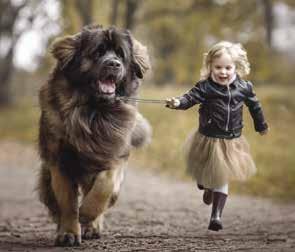
to thousands

neglect or distress each year, it is better for



involved if a situation can be resolved through support.
are many situations where animals have to be removed from violent or neglectful situations in order to relieve their distress and to protect them from future suffering,” he says. “But in other cases, people have temporarily fallen on hard times or have health issues that have impacted their ability to provide care. If someone wants to do the right thing for their pet, we’re here to help and to preserve that bond that is so important to both the animal and their guardian.”






Equestrian Canada (EC) is pleased to confirm the three officers of the Board for the 2022-23 year who were voted and confirmed by the Board of Directors on September 26, 2022.
Lisa Robertson takes on a new role as President, Christopher Lowe moves into the position of Vice President and Charles Cue is reaffirmed as Second Vice President.
Robertson, who resides in Regina SK was first elected to the board in 2020. A lifetime athlete, sports professional and equestrian, Robertson served the last year as Vice President 1 on the Board and led the Strategic Initiatives Planning (SIP) Committee for the Strategy 202225: Building for a Better Future.
Coming from an equestrian family originally from California, horses have been part of Robertson’s life from a very early age. She became a competitive show jumper when her family moved to Alberta in the 1980s. After a short three years in the province, she won a famed scholarship at the Spruce Meadows ‘Masters’ tournament that moved her to the show grounds for three years to train under Canadian Olympian Jonathan Asselin.
In addition to her riding, Robertson played five years with the University of Calgary women’s basketball program while earning a Bachelor of Arts in Communication degree where she was also a Canada West Universities Athletic Association champion and first-team all-star.
“ We are honoured and excited to see Lisa step into the President role.”

Currently Director of Sport, Community Engagement and Athlete Development at the University of Regina, prior to her current position, Robertson enjoyed a long tenure in the Athletic Department at the University of Calgary as Director of Development and then Associate Director of the Olympic Oval. She also has a long history of volunteerism with various local sport clubs and community associations.
Taking on a leadership role at a National Sport Organization some might say was inevitable with her personal athletic achievements as well as her successful career in sport program management. In addition to enjoying continued time in the saddle today as an adult amateur, Lisa’s show jumping experience coupled with her sport development and high-performance experiences helps inform her role on the Board and has prepared her for the challenges ahead.
“ The board and the organization under Chris Sorensen’s and Meg Krueger’s leadership became further stabilized and has set the future course through the new strategic plan and Vision 2030. I am so appreciative to him and the board for their work and now their trust in me,” said Robertson. “We are at the cusp of a new day for Equestrian Canada, and I am excited to be taking the reins at this time of growth and promise for the future!”
Christopher Lowe, a portfolio manager in Vancouver BC who also balances an equestrian career competing up to the 5* level, joined the board in 2021. With a desire to make an impact in a sport and industry he holds very dear, he is a member of the Finance Committee and was
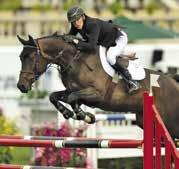
also on the SIP Committee this past year. Now as Vice President 1, he is looking to continue to combine his talents and passion for equestrian to help EC continue the progressive momentum of the organization.
“I think where I can add value to an organization like Equestrian Canada is, on the one hand, I understand the sport and actively compete at a reasonably high level and on the other, I’m a finance professional and can assess it from a business perspective.” said Lowe. Through this election, the Board agrees that Lowe will bring valuable insights to the work to come.
Charles Cue, a senior policy advisor and former Colonel in the Canadian Forces and at Veterans Affairs, joined the board in 2017. In addition to his lengthy service to Canada, his roots in the equestrian community also run deep as a co-owner of Rohan Wood Stables in Aylesford NS, a social enterprise that he helped establish in 2003 that ties business and charity together through a partnership with Free Spirit Therapeutic Riding Association.
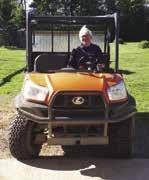
On the Board, Cue has been a judicious force and strong advocate for governance in both his role as Chair of the Governance Committee and Second Vice President. The board’s trust in his abilities was endorsed with his continuation for another year in his officer position.
“At this time of year, it is one of appreciation for those whose terms are now complete and a time to look forward to what’s next,” said Meg Krueger. “Chris Sorensen, Doug Orr, Carla Robin and Mark Goldman all made a significant impact and will be missed. Looking ahead, we have some new directors joining and having worked with all three of our newly elected officers over the past year, I am thrilled to have them leading the journey ahead.”
K rueger, who has been working together with Robertson, Lowe and the Board over the past 18 months on the new strategic plan, believes with these strong individuals and an excellent operational team, the future looks bright for EC.
“ The board has created a vision 2030 and a strategy 2025,” she continued. “This will provide the foundation for what we are going to be working towards over the next few years. We have a lot of work ahead to see it come together but with the leadership from Lisa, and our two VPs, we’re all feeling very optimistic.”
For more information on the EC Board of Directors, visit equestrian. ca/about/governance/board.
How much fun and laughter can you get in to one day? Answer – It’s unlimited at AERC shows.
2022 is the year of comeback for ‘in person’ horse shows and our September show was a great way to finish the Season. Several new faces and many familiar faces all came together with smiles and laughter.
A big thank you to our Judge Whitney Watson-Wilson and Ring Steward Morgan Goettler; you are both friendly, professional and a wonderful asset to the horse show ring.
The AERC would like to take the opportunity to acknowledge our members and the many families and friends that came out this year. To those of you who were showing, volunteering, watching, supporting and cheering; THANK YOU. Each and every one of you made 2022 a great show season.
L ast, but certainly not least, thank you to our judges. You took time out of your busy schedules to come out and support the Armstrong Enderby Riding Club. Your expertise, advice and feedback are greatly appreciated and helps build rider confidence, allowing us to progress in this sport of passion.
We are looking at dates for the 2023 show season, trying for 5 shows next year. We are also taking another look at our class list and lineup. Stay tuned.
Our AGM will be on November 2 at 7 pm; further details can be found on our Facebook page.
The Canadian Cowboy Challenge group held their final Challenge and Year-End Banquet on September 24 at the Stettler Agriculture Complex in Stettler AB. All competitors had to qualify for this Challenge. There were about 24 runs for the final Challenge which started at 9 am on the Saturday. The day went smoothly contributing to a great day for riders and everyone seemed to enjoy themselves.
There were 38 attending the Year-End Banquet which started at 6 pm with awards presented after the meal. The food was great (roast beef dinner) and everyone enjoyed the evening receiving their awards and reminiscing over the past Challenge season. Finals ribbons were given out to fifth place and awards consisted of a Cooler Bag with the CCC logo on it for first place. Second place was a director’s Chair with the CCC logo on it.
By Hans KollewynYear-end awards consisted of a belt buckle for the Champion and an embroilered black quilted vest with CCC logo, division, rider’s name and Reserve Champion on it.
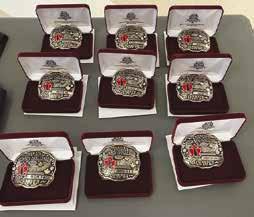
The year-end awards given out were: Shootin’ Sprouts Champion: Bailey Black riding Jazzy
Youth Champion: Sasha Rodriguez riding Sonny Reserve Champion: Sasha Rodriguez riding Tennyson
Novice Champion: Bailey Black riding Jazzy Reserve Champion: Tricia Melanson riding Chance
Buckin’ Crazies Champion: Denton Keith riding Bender
Reserve Champion: Leane Buxton riding Captain Rookie Champion: Koren LeVoir riding Shadow Reserve Champion: April Hall riding Badger Older Than Dirt Champion: Janet Goltz riding Mr Red Pines


Reserve Champion: Alana Eaton riding George Non Pro Champion: Koren LeVoir riding Shadow Reserve Champion: Greg Paranich riding Sonny Open Champion: Janet Goltz riding Mr Red Pines Reserve Champion: Alana Eaton riding George
It was a lot of work putting on a final and year-end banquet but well worth the time and effort. Set-up for the final Challenge was on Friday evening and reloading of obstacles into the trailer on Sunday morning. Even though this season has come to an end, the talk has already started about preparing for next season. The board met in October with other board meetings in November and December.
The Canadian Cowboy Challenge AGM will be held in late January 2023 via Zoom.
Stay safe and keep on riding.
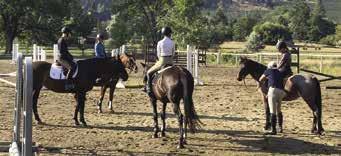
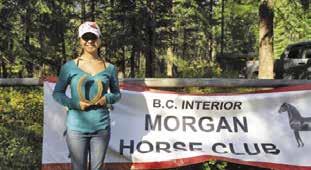
 By Nancy Roman
By Nancy Roman
WHAT A GREAT DAY FOR A POKER RIDE! Thank you to the 65 riders that came out and participated on September 25 at Timber Ridge Trails in Lumby. And thank you to our hostess Darlene for serving up some lunch and sharing some birthday cake (for Bianca Mackenzie). One of the Golden Horseshoes was found on the trail... by Morgan Knull of Enderby; the second one is still out there! The best Poker hand was won by David Roth (who happened to propose to his gal “Lisa” on the trail! Now engaged!) Guess he was feelin’ lucky!!
We also had many other door prize winners.
THANK YOU TO OUR SPONSORS... for your donations: Timber Ridge Trails, Country West Supply, Diamond H Tack, Fire Valley GlassWorks, Bonnie Spence, Laurie Lyons, Linda Ghesquire, Bianca Mackenzie, Ledge End Acres (Bev Routledge), Michelle Kozyn, McLuskey family.
Enjoy the rest of your riding season everyone! Keep an eye on our club Facebook page for updates and other news.
With the blazing heat of summer, one clinic and one show had to be re-scheduled. September began with Cheryl Keith’s Hunter/ Jumper Clinic on September 2-4. Biographies of our clinicians are found on our VDRC website. The Bill Ulmer Youth Clinic and Stable Management Rally was held on September 9-11 and well-attended. This timely clinic was followed by the annual Vernon Pony Club testing day on September 17. Congratulations to all athletes who tested for their riding and stable management. Instructor Marilee Moss and Dr. Susi Cienciala DVM partnered to offer a clinic on September 24-25 entitled: “Are You Listening? Understanding How Horses Learn.” This was completely filled and coincided with the last Percentage Day of the year for the club.
The Percentage Day on September 24 was fully booked with Olympian Eventer Mark Ishoy and Grand Prix Dressage Rider Lisa Bukowski judging. Both Mark and Lisa have represented Canada internationally. The VDRC Percentage Days have been a phenomenal success, with six dates offered and every one of them completely sold out. There is a great interest in Dressage and the club is hoping to recruit more volunteers to train for the clinics and shows. Please watch our Facebook page for volunteer training dates.
Our final event of the season was our fall Thankful Jumper Show on October 8-9. Saturday was the Schooling day and Sunday was Show day. There was a class for everyone, from Poles on the Ground to .90 Jumper, Speed Classes and Mini Prix. It was a beautiful day to come down to the club as either a competitor or observer. The club would like to thank Keelly Gordon for organizing this last show. VDRC closed at the end of October for the 2022 season.
L ast of all we would like to take a moment to acknowledge the end of the 70 year reign of Queen Elizabeth II who was a true horsewoman, riding all her life and actively involved and deeply interested in the care and lives of each of her horses.


On September 24 and 25 Cariboo Country Carriage Club, a branch of BCCDS hosted the Cariboo Trails Extended Field Driving Trials, The Back-to-Back. The event was attended by 20 drivers with various breeds and types of equine partners.



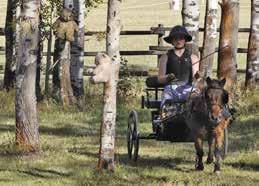
The first day of the event saw Training won by Marion Roman, driving her Quarter Pony Rumor Has It; followed by Emma Barron driving her VSE Hosea; third was Karyn Greenlees driving her Connemara Devon’s Dun Maple; and fourth was taken by Sasha Hopp driving her Welsh mare Pip.


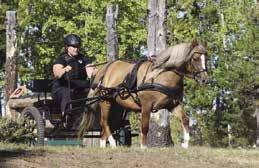

In Preliminary Ellen Hockley placed first with her Fjord-X mare Tammy; second was taken by Joni Peters driving her Quarter Horse Scout; followed by Theo Mediema, from Fort St John, driving his pair of Welsh-X ponies. In fourth place was Eric Sdoutz driving Fergus, a Gypsy Vanner.
Day two saw new placements with Training won by Emma Barron driving Hosea, followed by Hillory McNolty driving her Morgan Tux; Racheal Sdoutz driving her Morgan Bear; and in fourth place was Sasha Hopp for the second day. Preliminary was taken by Joni Peters driving Scout; followed by Ellen Hockley and Tammy; Ken Huber driving his Welsh Huber’s Grey Ghost took third; and Eric Sdoutz and Fergus taking fourth.
The end of the weekend found Emma Barron taking First Over-All in Training and Joni Peters taking Preliminary First Over-All.
We also need to mention Laraine Sheddon and her donkey Abraham who, on day two, with a dressage test of 37.10 and a double clear in cones, was in first place in Training. As the marathon approached, Laraine noticed a small cinch rub on Abe’s side caused when his cart shaft broke the day before. Because her equine partner’s health is more important than a win, she chose to withdraw from the event.
Another driver that should be mentioned is Alisha Brandle driving at her first event, she managed to complete the marathon on both days with her little Welsh mare Huber’s Vanilla Ice. She will be a contender next year!
The Cariboo Country Carriage Club members would like to thank all the drivers who have attended our events over the last season, and we are looking forward to next year’s events. We would also like to make a big shout out to the volunteers that come out and help us put on these events. We have a very small group that we can count on to be there each and every time. Thank you all so much!
With cattle hard to find and lots of demand, it all managed to come together for a one day finale at a brand new venue for the club! Shaun Howe’s family went way above and beyond to host a show at their spectacular property right on top of Sumas Mountain in Abbotsford BC. Traveland RV is the Howe’s family business and their support and sponsorship has been amazing.
Gord (A&J Stock Cartage) made a smooth job of delivering the cattle, supplied by Hopcotts and fed with hay donated by Cedarbrink Dairy Farm. The national anthem was sung with Kristen Burke and Freckles doing a stellar job riding around the arena with the flag. The first herd in and settled with Judge Wendy Garrard in position, pencil at the ready.
A little after 4 p.m. Brent Stewart stepped up to the microphone and auctioned off the brave souls who had agreed to dress up and compete in the fundraising Calcutta. The rider gets dressed in any thing that would disguise their common sense, mounted on their horse with a loop of string making a poor substitute for a more useful bit and bridle. With the music cranked and the crowd going wild, they go cut. Each team is bid on and the proceeds get split between the rider and Canuck Place. A lot of fun to watch and a nice little cheque for a great cause! Anna took the win sporting some spectacular pig tails and Doug’s blond flowing wig cast him in a whole new light for a lot of us (thanks for the help with the cows by the way Doug!).
The host Howes family just kept on giving, cooking us a great BBQ where we had a chance to mingle and witness the attempts at getting across the pond on a zip line that was pretty unforgiving if you didn’t have the knack. Several didn’t make it across with the only way back to dry land was … well by getting wet!
There were a lot of people to thank for making this show and our other shows happen. The turnback and corner riders, the trainers that share their knowledge, Janice who takes such great pictures, and of course our sponsors who have helped the club end up well set up for another year.
CLASS WINNERS
Open: Binky Moffat riding CY Runaround Sue
Never Won A Buckle: Victoria Holmes got a nice 70 on Footprints By Gypsy
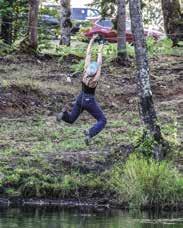
$10,000 Novice Horse: Lorne McCavany on Hylite Slidin Chase with a 73
Non-Pro: Binky Moffat picking up another win on CY Runaround Sue
Youth: Camryn Howes got the high score of the show with a 74 on Scatt Daddy
Novice: Fred Weins on Two Timin Texan with a 71
$15,000 Amateur: Jill Hamilton on Catlight
$35,000 Non Pro: Deb Hall and Sanjo Royal with a 73
$2,500 Ltd Rider: Julie Karlsen on SQH Thriftshop
$750 Progressive Horse: Brent Stewart and RCR Fancy Lookin Cat
$350 Ltd Rider: Bailey Underwood and Hickory Travelin King
$200 Ranch Open: Reyflection and Kat Kowalik

$200 Ranch NP: Chelsea Beaton and She’s A Pistol Annie
Draw Saddle Sponsor: Dolphin Mechanical Services
Never Won A Buckle Sponsor: Copper Reata Home Décor
$2,500 Limit Rider Incentive: Bill and Karen Rempel


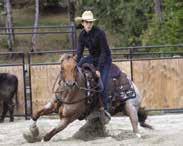

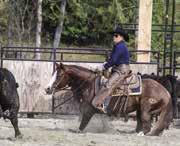

$350 Limit Rider Incentive: Paton and Martin Veterinary Services
Show/General Club Sponsors:
Ritchie Smith Feeds-Harmony Line
Janice Reiter Photography
K D Saddle Blankets
Super Save Country Feeds
The Mill Store
Traveland RV
K&K Livestock
Butcher Bob’s
Embroidery
By GypsyWhere’s the fire? Deb Hall and Sanjo Royal are on their way
Will she or won’t she make it across?
Oh boy, Doug Vandekerkhove and Rio Merada light things up
Buckle Sponsors: West Coast Equine Spa Highland Lowbed Stewart Performance Horses Emerald Spring Farm Paton and Martin Veterinary Services
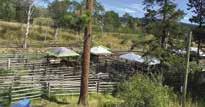
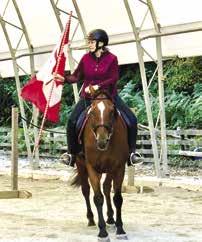 By Kendra Kowalski
By Kendra Kowalski
Vintage Riders BC is a group of (mostly mature) women who share knowledge and friendship. Shortly, the club will be twenty years old. Surprises are being planned. Some involve CAKE. Yay! Possibly on offer is a local overnight camping event, with your horse. We have done this before and it is great fun, but it requires the help of many. So put whatever skills you have to good use for those that are grateful, and get yourself on the committee.
Recent clinics were a repeat and progression of gymnastic work over poles. It is a lot of physical work to set all those pole patterns. Your students look forward to this Jesse Blackmon. Your efforts and expertise are appreciated. Great success!
Another event of note was time spent with Tabitha Hepworth. Organized as ever, the Cowboy Challenge course was both complicated and fun. Horses and riders of different skill and training levels were grouped together and given specific ride times. All went smoothly. In an inclusive atmosphere, everyone worked on their horse communication and equitation development. This was held at one of our members’ properties. So good of her to let us come and play at her house.
Join us if you like to ride any discipline, or try new ones. We welcome ideas for clinics, guest speakers and field trips. Participation in related community service is encouraged. How do you feel about whacking blackberry vines on our public horse trails? What’s that line about suffering for your sport? On offer is the opportunity to be social and share the company of like-minded people. Sometimes there is cake!
Many of us learned to ZOOM over the past few years, when it wasn’t safe to hold our meetings in person. Zooming was a stumbling sort of process to begin with, but proud of us all for figuring that one out. We have generous members who are good at this stuff and taught us all. Thank you.
Fortunately, we are now able to meet in person again. Our last guest speaker is involved with equine emergency rescue and disaster preparedness; a very involved presentation. With a great deal of information that opened our eyes to what can and does happen, and the good people who have the knowledge and decency to problem solve for those in need.
Coming up next meeting is a talk on nutrition and supplements. A timely topic going into winter, when it is entirely up to us to see that our horses get what they need.
Each year a group of our more adventurous Vintage Riders trailer out of town to ranch ride at the Seven 1⁄2 Diamond establishment. When asked how it went, I was told, wonderful experience. Emphasis was on safety, with small group rides going out. So that things didn’t turn into a cavalry charge. When queried on the socializing, I was told with giggles and winks, “What goes on at the ranch, stays at the ranch.”
We have done it before, and are keen to try again… Square Dancing on horseback. Our caller is a Vintage alumnus, who is willing to come back to the lower mainland one more time. She will sort us out to music. Time and place yet to be announced. Cake might be required at this one to keep our mouths shut from laughing too hard, and falling off.
Many members thrive outside of club activities. Lots of interest in Working Equitation Canada. This past summer the Manitoba chapter offered five virtual fun shows. Now that is thinking outside of the box. I tried it. Loved it. It supplied great goals and a clear schooling pathway for my horse. Vintage Riders supplied the confidence for this oldster. Dressage is fairly easy to set up. But the Ease of Handling obstacle courses presented some challenges. Building them flexed some muscles and stretched the imagination. I was pleasantly surprised when Fynn and I received placings.
Vintage Riders is a club with a common bond of regard for the horse... which supplies the means to cement friendships lasting decades. Now that calls for cake!
Ride on my friends, Kendra Kowalski
One further thought, quoting Ray Hunt. “People have to learn that whatever the horse is doing is right. You are the one who got into his life, he didn’t get into yours. It is amazing what a horse will go through to satisfy a human being.”

Vintage Riders Equestrian Club… for the love of horses! We are a gathering of horse enthusiasts within the Fraser Valley. Anyone over the age of 21 is welcome. We meet every 3rd Tuesday in Fort Langley to enjoy fellowship and a speaker and host a variety of clinics according to PHO.
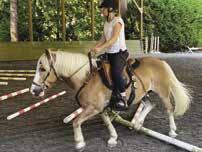
Find us on Facebook at Vintage Riders Equestrian Club – public, email: vintageriders@ shaw.ca
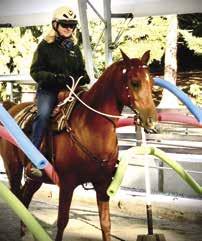

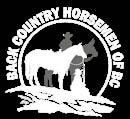 By Leslie Battersby, BCHBC Prince
By Leslie Battersby, BCHBC Prince
Our annual Rendezvous (RV) and in-person AGM is, by far, the largest gathering of our province-wide organization. Depending on the location, up to 300 members and guests (with and without horses) gather to socialize, attend training sessions and demos, trail ride, and share ideas for improving their backcountry skills and horsemanship.
Yippee ki-yay! It finally happened! After the Prince GeorgeOmineca (PG-O) Chapter’s BCHBC Rendezvous was postponed for two years due to COVID it was finally held June 24-26, 2022 at the Prince George Rodeo Grounds, CN Centre and Agriplex. A total of 120 folks attended from across the province. The farthest away was from Vancouver Island.
The PG-O Chapter was founded in 2016 and currently consists of 60 members. Prince George is located in the heart of the central interior and is considered “the gateway to the North,” as Highway 97 (North/South) and Highway 16 (East/West) intersect here. The Omineca (meaning “slow-moving water”) district covers the northcentral interior section of BC.
To ensure that this three-day event was successful, there was considerable long-term planning by RV Committee chair, Sandra Erickson, and her supportive team of volunteers and generous sponsors. Without their dedication, RV would not have happened! So a big ‘kudos’ and cowboy hats off must go out to them! Some of the clinics and activities included Courtney Gledstone, Equusoul Equine First Aid; Kyla Strange Horsemanship Clinics; Pernell Fleck Horsemanship 101 Trail Control Clinics; and Russell Floyd, Back Country Blacksmiths. Russell presented an informative session on guide and pack training and this clinic also included a fun packing competition. Winners of the packing competition were Perry and Katja Beamish.
Social Events, Networking and Trail Rides!
Friday night featured a delicious BBQ, compliments of the PG-O Chapter and hosted by the Northern Interior Drill Team. The evening was topped off with live music by cowboy singer/songwriter Bernadette Ducharme and a drill team performance.
Saturday we had our AGM, Cowboy Poetry Contest, and an evening dinner, dance—with Prince George-based country singer Rick Staveley—and a silent auction.
Sunday featured a pancake breakfast and cowboy church. There were also sanctioned trail rides each day. Some rides wandered through the multi-use recreational trails with shaded trees and groomed sections. This trail system is a huge area with many trails and maps posted to find routes. On the trail ride that I attended on Sunday, there were 13 riders of various ages and ‘Jake’ was the oldest horse at 29.
O ther weekend activities included a tack ID info table, a trailer-
 Chapter
Chapter
safety demo by CVSE officer Andrea Garhammer, a Dutch Oven demo and cook-off, massage demo by Althea Equine Massage and the Escape Room activity, won by a team from Mackenzie.
The winner of the Ernie Buckles Cowboy Poetry Contest and our Volunteers of the Year will be published in the December issue of Saddle Up magazine.
To read a longer version of this month’s article, visit the ‘Latest News’ page at bchorsemen.org.

BC
BC
BC





BC
BC








BOUCHIE


SOUTH CENTRAL QUARTER HORSE ASSOC., Host of April Fuzzy Horse Show and September


Show, http://bcqha.com/index.php/scqha
VINTAGE RIDERS EQUESTRIAN CLUB (Fraser Valley BC), English/Western, lectures,


safe and fun, vintageriders@shaw.ca, on Facebook 4/23
WILD ROSE DRAFT HORSE ASSOCIATION, www.wrdha.com. Barb Stephenson (Secretary) phone 403-933-5765 (8:00 am to 8:00 pm) 6/23








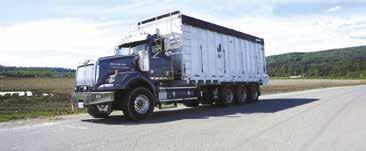


ANIMAL CARE HOSPITAL Williams Lake 250-392-5510 / Quesnel 250-747-3053 Drs. Magnowski, Scheidt, Thompson, Jordan, Deitrick



INTERIOR VETERINARY
(Okanagan) 250-769-4217,
Equine, Brytann Youngberg DVM, VSMT, College of
Chiropractors 9/23
WALES EQUINE VETERINARY
(Okanagan) 250-258-2299 Drs. Alex Wales and Dr. Susan Wales, www.walesequine.com 9/23

